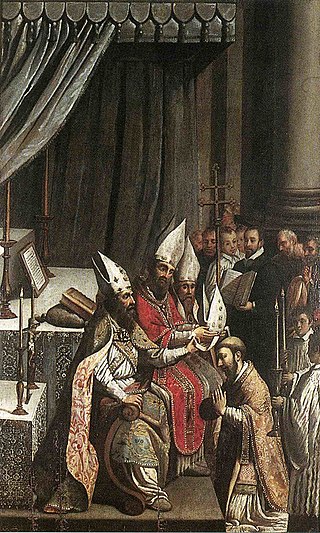
Apostolic succession is the method whereby the ministry of the Christian Church is considered by some Christian denominations to be derived from the apostles by a continuous succession, which has usually been associated with a claim that the succession is through a series of bishops. Those of the Catholic, Eastern Orthodox, Scandinavian Lutheran, Anglican, Oriental Orthodox, Church of the East, Hussite, Moravian and Old Catholic traditions maintain that "a bishop cannot have regular or valid orders unless he has been consecrated in this apostolic succession". These traditions do not always consider the episcopal consecrations of all of the other traditions as valid.

The Eastern Orthodox Church, officially the Orthodox Catholic Church, and also called the Greek Orthodox Church or simply the Orthodox Church, is the second-largest Christian church, with approximately 230 million baptised members. It operates as a communion of autocephalous churches, each governed by its bishops via local synods. The church has no central doctrinal or governmental authority analogous to the head of the Catholic Church. Nevertheless, the Ecumenical Patriarch of Constantinople is recognised by them as primus inter pares, a title formerly given to the patriarch of Rome. As one of the oldest surviving religious institutions in the world, the Eastern Orthodox Church has played an especially prominent role in the history and culture of Eastern and Southeastern Europe.

Palm Sunday is the Christian moveable feast that falls on the Sunday before Easter. The feast commemorates Christ's triumphal entry into Jerusalem, an event mentioned in each of the four canonical Gospels. Its name originates from the palm branches waved by the crowd to greet and honor Jesus Christ as he entered the city. Palm Sunday marks the first day of Holy Week; in Western Christianity, this is the beginning of the last week of the solemn season of Lent, preceding Eastertide, while in Eastern Christianity, Holy Week commences after the conclusion of Great Lent.

The World Council of Churches (WCC) is a worldwide Christian inter-church organization founded in 1948 to work for the cause of ecumenism. Its full members today include the Assyrian Church of the East, the Oriental Orthodox Churches, most jurisdictions of the Eastern Orthodox Church, the Union of Utrecht, the Lutheran World Federation, the Anglican Communion, the Mennonite churches, the World Methodist Council, the Baptist World Alliance, the World Communion of Reformed Churches, the Pentecostal churches, the Moravian Church and the Malankara Mar Thoma Syrian Church. Notably, the Catholic Church is not a full member, although it sends delegates to meetings who have observer status.
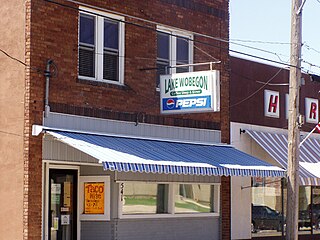
Holdingford is a city in Stearns County, Minnesota, United States. The population was 708 at the 2010 census. It claims to be "The Gateway to Lake Wobegon", the fictional central Minnesota town created by author Garrison Keillor.

The Ethiopian Orthodox Tewahedo Church is the largest of the Oriental Orthodox Churches. One of the few Christian churches in sub-Saharan Africa originating before European colonization of the continent, the Ethiopian Orthodox Tewahedo Church dates back to the Christianization of the Kingdom of Aksum in 330, and has between 36 million and 51 million adherents in Ethiopia. It is a founding member of the World Council of Churches. The Ethiopian Orthodox Tewahedo Church is in communion with the other Oriental Orthodox churches.
The Patriarch of Antioch is a traditional title held by the bishop of Antioch. As the traditional "overseer" of the first gentile Christian community, the position has been of prime importance in Pauline Christianity from its earliest period. This diocese is one of the few for which the names of its bishops from the apostolic beginnings have been preserved. Today five churches use the title of patriarch of Antioch: one Oriental Orthodox ; three Eastern Catholic ; and one Eastern Orthodox.

The history of Christianity in Ukraine dates back to the earliest centuries of the history of Christianity, to the Apostolic Age, with mission trips along the Black Sea and a legend of Andrew the Apostle even ascending the hills of Kiev. The first Christian community on territory of modern Ukraine is documented as early as the 9th century with the establishment of the Metropolitanate of Gothia, which was centered in the Crimean peninsula. However, on territory of the Old Rus in Kiev, Christianity became the dominant religion since its official acceptance in 989 by Vladimir the Great, who brought it from Byzantine Crimea and installed it as the state religion of medieval Kievan Rus (Ruthenia), with the metropolitan see in Kiev.
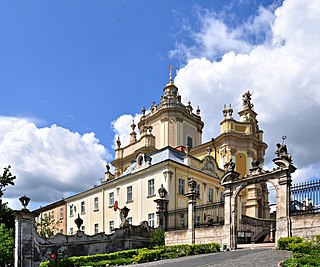
The Ukrainian Greek Catholic Church (UGCC) is a major archiepiscopal sui iuris ("autonomous") Eastern Catholic church that is based in Ukraine. As a particular church of the Catholic Church, it is in full communion with the Holy See. It is the second-largest particular church in the Catholic Church after the Latin Church. The major archbishop presides over the entire Church but is not distinguished with the patriarchal title. The incumbent Major Archbishop is Sviatoslav Shevchuk.
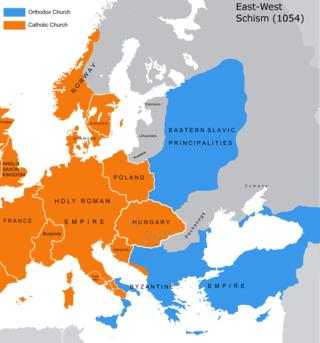
The East–West Schism, also known as the Great Schism or the Schism of 1054, is the break of communion between the Catholic and Eastern Orthodox churches since 1054. A series of ecclesiastical differences and theological disputes between the Greek East and Latin West preceded the formal split that occurred in 1054. Prominent among these were the procession of the Holy Spirit (Filioque), whether leavened or unleavened bread should be used in the Eucharist, iconoclasm, the coronation of Charlemagne as Emperor of the Romans in 800, the Pope's claim to universal jurisdiction, and the place of the See of Constantinople in relation to the pentarchy.
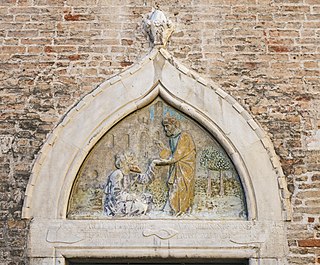
Pope Anianus was the 2nd Patriarch of Alexandria. He was ordained by Saint Mark the Evangelist, and was also the first convert Mark won to Christianity in the region.

Dryburgh Abbey, near Dryburgh on the banks of the River Tweed in the Scottish Borders, was nominally founded on 10 November (Martinmas) 1150 in an agreement between Hugh de Morville, Constable of Scotland, and the Premonstratensian canons regular from Alnwick Abbey in Northumberland. The arrival of the canons along with their first abbot, Roger, took place on 13 December 1152.

Pope John Paul II's relations with the Eastern Orthodox Church were marked by a significant improvement in relations between Roman Catholicism and Eastern Orthodoxy.
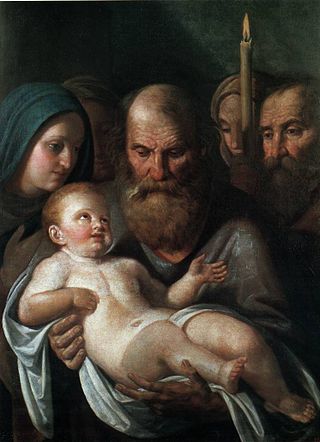
Simeon at the Temple is the "just and devout" man of Jerusalem who, according to Luke 2:25–35, met Mary, Joseph, and Jesus as they entered the Temple to fulfill the requirements of the Law of Moses on the 40th day from Jesus' birth, i. e. the presentation of Jesus at the Temple.

February 3 - Eastern Orthodox liturgical calendar - February 5

Alexis Georgievich Toth was a Russian Orthodox church leader in the Midwestern United States who, having resigned his position as a Byzantine Catholic priest in the Ruthenian Catholic Church, became responsible for the conversions of approximately 20,000 Eastern Rite Catholics to the Russian Orthodox Church, which contributed to the growth of Eastern Orthodoxy in the United States and the eventual establishment of the Orthodox Church in America. He was glorified by the Orthodox Church in 1994.

The Ethiopian Catholic Church or Ethiopian Eastern Catholic Church is a sui iuris (autonomous) Eastern Catholic church that is based in Ethiopia. As a particular church of the Catholic Church, it is in full communion with the Holy See. Established in 1930, the church is organised under a metropolitan bishop who exercises oversight of a number suffragan dioceses. In its liturgical services, it uses the Alexandrian Rite in the Ge'ez language.

Eritrea as a country and the Eritrean community are multi-religious. Eritrea has two dominant religions, Christianity and Islam.

The Estonian Orthodox Church of the Moscow Patriarchate is a semi-autonomous church in the canonical jurisdiction of the Patriarchate of Moscow whose primate is appointed by the Holy Synod of the latter.

Dave Dryburgh was a Scotland-born Canadian sports journalist. A native of Kirkcaldy and an immigrant to Regina, he reported on the soccer games in which he played for The Leader-Post. As the newspaper's sports editor from 1932 to 1948, he primarily covered Canadian football and the Regina Roughriders, and ice hockey in Western Canada. His columns "Sport Byways" and "Dryburgh" give a first-hand account of sporting events, and were read widely in Western Canada. As the secretary of the Saskatchewan Amateur Hockey Association during the 1930s and 1940s, he established its registration system including the history of each player. He also served as the official statistician for baseball, softball and hockey leagues in Saskatchewan.


















